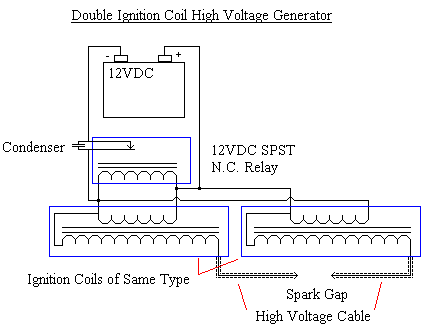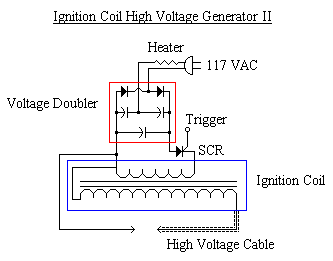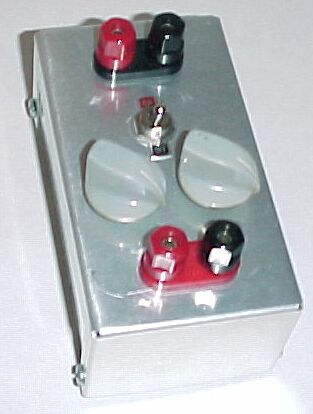

This next design is similar to the one above, but uses two coils with their primaries in
parallel (but the + on one is to the - on the other and vice versa) and their secondaries in
series. This has a higher voltage output than using just one. The average voltage output
is two times that of using just one. You can create longer arcs with this, but it takes up
more power.

The way the two above diagrams work is by using a pulsing current produced by the relay to drive the coil(s). The current runs through the coil of the relay by passing through the normally closed contacts. This induces a magnetic field in the coil causing the contacts to open. Because the contacts are open, the current is no longer running through the coil. Thus, the coil is no longer producing a magnetic field, so the contacts close, and the cycle is repeated.
The purpose of the condenser is to reduce arcing on the contacts of the relay, and to improve the performance of the ignition coil. If you remove the condenser, the contacts will wear away quickly, and get very hot, and the ignition coil will give off weak sparks. You can find the condenser at just about any auto parts store.
In this ignition coil driver a voltage doubler is used to create about 340VDC from the
120VAC line (the peak voltage of 120VAC is 170), which is then discharged out of the
capacitors through the ignition coil by means of an SCR. It is not necessary to use a
voltage doubler, it can also be a tripler, quadrupler, even just a capacitor and diode
(or bridge). And the input voltage can be 120VAC or 240VAC. As for the SCR, it can
be a triac, relay, or just a switch.

When making the voltage doubler (if thats what your using, but this goes for every other option too) you should use photo flash capacitors. This is because they are designed for a rapid discharge. It is fine to use regular capacitors, but they could get hot, and even explode. For the heater, it can be anything like a toaster, oven, light bulb, iron, etc... You will need it, though, because when you trigger the SCR, its almost like your shorting out the power. If you leave this out you will throw a breaker, and probably destroy some components.
You will have to experiment with the values of the capacitors, and heater to get it to work right, though. If you have a very low resistance heater, and large capacitors, once you trigger the SCR, the voltage drop in the capacitors will never reach 0, and the SCR will remain in conduction. But if you are using a relay or a switch you wont need to worry about this. And the higher the frequency at which you wish to drive the coil, the harder it will be. But dispite the fact it is hard to figure out the values of everything for best results when using an SCR or triac, you normally get better results using them instead of something like a relay or switch.
Another way to drive ignition coils is to use a 555 timer pulse generator. A 555 generates
a square wave output that triggers the 2N3055. Adjusting the two potentiometers and the
value of the capacitor will change the frequency of the output.

When you connect an ignition coil to the output of the pulse generator, you can change the frequency of the output to change the properties of the arc from the ignition coil. This can make some very hot arcs, and it is even possible to make a small Jacob's ladder (see the section on Jacob's ladders for more information). But this pulse generator can also power normal transformers. I stepped up the voltage to 120volts, and powered one of those digital clocks with it. When you change the frequency of the pulse generator, you can make the clock count faster or slower. I was able to make the minutes on the clock count even faster than once every second.
Also, when making the pulse generator I would recommend using sockets for the IC in case it breaks. You can then easily replace the non-working IC with a new one. You should also put in a socket for the capacitor so you can easily put in different value capacitors.

Above is a picture of my pulse generator. I put it in a case and everything, but I do use it
a lot. Though I had a little trouble fitting everything in.
These ignition coil high voltage generators can be used for several things, such as experimentation, an electric fence, and the ignition of fireworks, a gas fireplace, grill, stove, or furnace (caution), or just for fun.